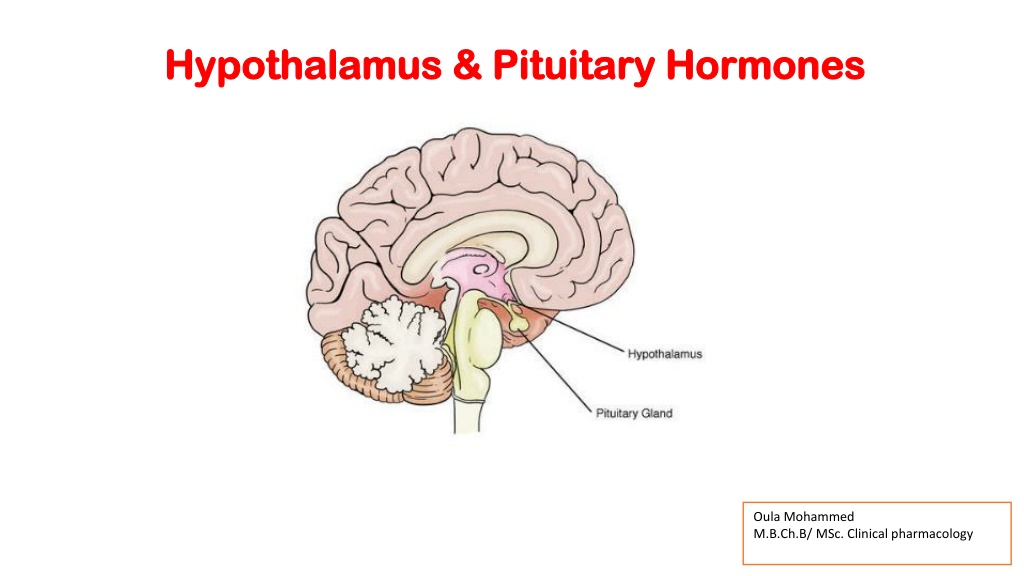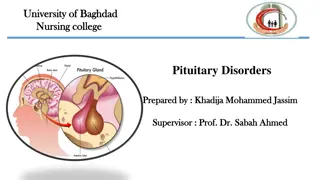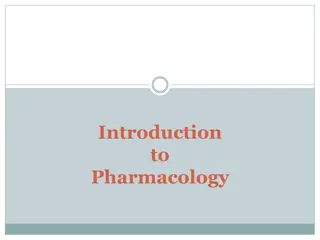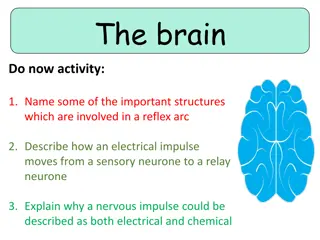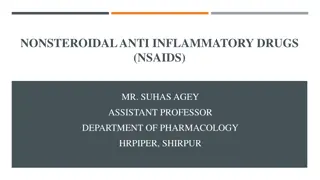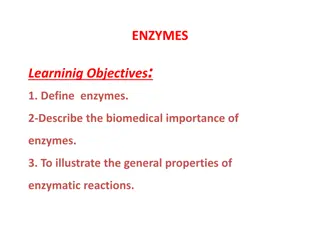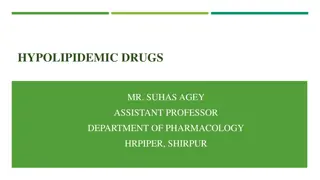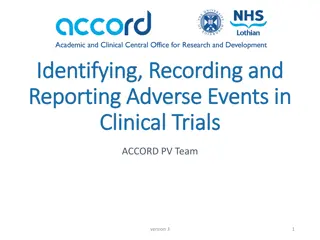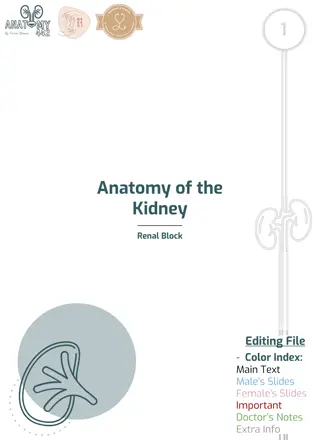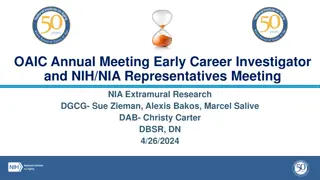Understanding Hypothalamus and Pituitary Hormones in Clinical Pharmacology
Peptides and glycoproteins are secreted by the hypothalamus and pituitary, regulating anterior pituitary hormones. Hormones like adrenocorticotropic hormone (ACTH) and corticotropin-releasing hormone (CRH) play crucial roles. Synthetic adrenocorticosteroids have limited the use of corticotropin for diagnostic purposes. ACTH is also employed in treating conditions like infantile spasms and multiple sclerosis, with some potential adverse effects.
Download Presentation
Please find below an Image/Link to download the presentation.
The content on the website is provided AS IS for your information and personal use only. It may not be sold, licensed, or shared on other websites without obtaining consent from the author. Download presentation by click this link. If you encounter any issues during the download, it is possible that the publisher has removed the file from their server.
Presentation Transcript
Hypothalamus & Pituitary Hormones Hypothalamus & Pituitary Hormones Oula Mohammed M.B.Ch.B/ MSc. Clinical pharmacology 1
The hormones secreted by the hypothalamus and the pituitary are peptides or glycoproteins that act by binding to specific receptor. The hormones of the anterior pituitary are regulated by neuropeptides that are called either releasing or inhibiting factors or hormones. These are produced in the hypothalamus, and they reach the pituitary by the hypophyseal portal system. Each hypothalamic regulatory hormone controls the release of a specific hormone from the anterior pituitary. Pituitary hormone preparations are currently used for specific hormonal deficiencies, although most of the agents have limited therapeutic applications. Hormones of the anterior pituitary are administered intramuscularly (IM), subcutaneously, or intranasally because their peptidyl nature makes them susceptible to destruction by proteolytic enzymes of the digestive tract.
1-Adrenocorticotropic hormone (corticotropin) (ACTH) Corticotropin-releasing hormone (CRH) is responsible for the synthesis and release of the peptide proopiomelanocortin by the pituitary .[Note: CRH is used diagnostically to differentiate between Cushing (disease tumor in the pituitary syndrome and ectopic ACTH-producing cells.] ( if we have high level of ACTH & cortisol and can`t differentiate between Cushing disease and ectopic ACTH-producing cells we can give CRH, if the level of ACTH increased further more ( pituitary tumor ) , if ACTH not changed ( ectopic ACTH tumor as in small cell lung CA). Normally, ACTH is released from the pituitary in pulses with an overriding diurnal rhythm, with the highest concentration occurring in early morning and the lowest in late evening. Stress stimulates its secretion, whereas cortisol acting via negative feedback suppresses its release ACTH binds to receptors on the surface of the adrenal cortex, thereby stimulate the conversion of cholesterol to pregnenolone & the synthesis and release of adrenocorticosteroids and the adrenal androgens. 5
Therapeutic uses The availability of synthetic adrenocorticosteroids with specific properties has limited the use of corticotropin mainly to serving as a diagnostic tool for differentiating between primary adrenal insufficiency (Addison disease,associated with adrenal atrophy) and secondary adrenal insufficiency (caused by inadequate secretion of ACTH by the pituitary). Therapeutic corticotropin preparations are extracts from the anterior pituitaries of domestic animals or synthetic human ACTH. The latter, cosyntropin , is preferred for the diagnosis of adrenal insufficiency. ACTH is also used in the treatment of infantile spasms ( induce steroid release and decreasing neuronal excitability ) and multiple sclerosis ( anti-inflammatory ). Adverse effects Short-term use of ACTH for diagnostic purposes is usually well tolerated. With longer use, toxicities are similar to glucocorticoids and include hypertension, peripheral edema, hypokalemia, emotional disturbances, and increased risk of infection. 6
2-Growth hormone (somatotropin) Somatotropin is released by the anterior pituitary in response to growth hormone (GH)-releasing hormone . Conversely, secretion of GH is inhibited by the hormone somatostatin. GH is released in a pulsatile manner, with the highest levels occurring during sleep. With increasing age, GH secretion decreases, accompanied by a decrease in lean muscle mass. Somatotropin influences a wide variety of biochemical processes (for example, cell proliferation and bone growth). Synthetic human GH (somatropin) is produced using recombinant DNA technology. 7
Mechanism of action Although many physiologic effects of GH are exerted directly at its targets, others are mediated through the somatomedins insulin-like growth factors 1 and 2 (IGF-1 and IGF-2). [Note: In acromegaly (a syndrome of excess GH due to hormone-secreting tumors *benign*), IGF-1 levels are consistently high, reflecting elevated GH. Therapeutic uses Somatropin is used in the treatment of GH deficiency, growth failure in children, treatment of HIV patients with cachexia, and GH replacement in adults with confirmed deficiency. [Note: GH administered to adults increases lean body mass (total weight minus body fat ), bone density, and skin thickness, and decreases adipose tissue. Many consider GH an antiaging hormone. This has led to off-label use of GH by older individuals and by athletes seeking to enhance performance.] Somatropin is administered by subcutaneous or IM injection. Although the half-life of GH is short (approximately 25 minutes), it induces release of IGF-1 from the liver, which is responsible for subsequent GH-like actions. Adverse effects Pain at the injection site, edema, arthralgias, myalgias, nausea, and an increased risk of diabetes. Somatropin should not be used in pediatric patients with closed epiphyses, patients with diabetic retinopathy, or obese patients with Prader-Willi syndrome. 8
3-Somatostatin (growth hormoneinhibiting hormone) In the pituitary, somatostatin binds to receptors that suppress GH and thyroid-stimulating hormone (TSH) release. Originally isolated from the hypothalamus, somatostatin is a small polypeptide found in neurons throughout the body as well as in the intestine, stomach, and pancreas. Somatostatin not only inhibits release of GH but also insulin, glucagon, and gastrin. Octreotide and lanreotide are synthetic analogs of somatostatin with longer half-lives. Depot formulations of these agents allow for administration every 4 weeks. They have found use in the treatment of acromegaly and in severe diarrhea/flushing episodes associated with carcinoid tumors. An intravenous infusion of octreotide is also used for the treatment of bleeding esophageal varices. Adverse effects of octreotide include bradycardia, diarrhea, abdominal pain, flatulence, nausea, and steatorrhea. Gallbladder emptying is delayed, and asymptomatic cholesterol gallstones can occur with long-term treatment. 9
4-Gonadotropin-releasing hormone Pulsatile secretion of gonadotropin-releasing hormone (GnRH) from the hypothalamus is essential for release of the gonadotropins follicle-stimulating hormone (FSH) and luteinizing hormone (LH) from the anterior pituitary. However, continuous administration of GnRH inhibits gonadotropin release. Continuous administration of synthetic GnRH analogs, such as leuprolide , is effective in suppressing production of FSH and LH . Suppression of gonadotropins, in turn, leads to reduced production of gonadal steroid hormones (androgens and estrogens). Thus, these agents are effective in the treatment of prostate cancer, endometriosis, and precocious puberty. Leuprolide is also used to suppress the LH surge and prevent premature ovulation in women undergoing controlled ovarian stimulation protocols for the treatment of infertility. [Note: GnRH antagonists such as cetrorelix and ganirelix can also be used to inhibit LH secretion in infertility protocols.] In women, the GnRH analogs may cause hot flushes and sweating, as well as diminished libido, depression, and ovarian cysts. They are contraindicated in pregnancy and breast-feeding. In men, they initially cause a rise in testosterone that can result in bone pain. Hot flushes, edema, gynecomastia, and diminished libido . 10
GnRH analog suppress sex hormone 11
GnRH antagonists such as cetro inhibit LH secretion in infertility allows multiple follicles to mature) cetrorelix infertility (suppression LH prevents premature ovulation , this relix & gani ganirelix relix can also be used to 12
5- Gonadotropins The gonadotropins (FSH and LH) are produced in the anterior pituitary. The regulation of gonadal steroid hormones depends on these agents. They find use in the treatment of infertility. 1. Menotropins (also known as human menopausal gonadotropins or hMG) are obtained from urine of postmenopausal women and contain both FSH and LH. 2. Urofollitropin is FSH obtained from postmenopausal women and is devoid of LH. 3. Follitropin alfa and follitropin beta are human FSH products manufactured using recombinant DNA technology. 4. Human chorionic gonadotropin (hCG) is a placental hormone that is excreted in urine of pregnant women. The effects of hCG and choriogonadotropin alfa (made using recombinant DNA technology) are essentially identical to those of LH. All of these hormones are injected via the IM or subcutaneous route. Injection of hMG or FSH products over a period of 5 to 12 days causes ovarian follicular growth and maturation, and with subsequent injection of hCG, ovulation occurs. Adverse effects include ovarian enlargement and possible ovarian hyperstimulation syndrome, which may be life threatening. Multiple births can occur 13
6-Prolactin Prolactin is a peptide hormone secreted by the anterior pituitary. Its primary function is to stimulate and maintain lactation. In addition, it decreases sexual drive and reproductive function. Thyrotropin-releasing hormone stimulates the release of prolactin, and secretion is inhibited by dopamine acting at D2 receptors [Note: Drugs that act as dopamine antagonists (for example, metoclopramide and some antipsychotics) can increase the secretion of prolactin.] Hyperprolactinemia, which is associated with galactorrhea and hypogonadism, is treated with D2 receptor agonists, such as bromocriptine and cabergoline. Both of these agents also find use in the treatment Bromocriptine is also indicated for treatment of type 2 diabetes ( decrease insulin resistance ). Among their adverse effects are nausea, headache and, less frequently, psychosis. of pituitary microadenomas. 16
Prolactin D2 receptor agonists dopamine antagonists antipsychotics 17
Hormones of the Posterior Pituitary In contrast to the hormones of the anterior lobe of the pituitary, those of the posterior lobe, vasopressin and oxytocin, are not regulated by releasing hormones. Instead, they are synthesized in the hypothalamus, transported to the posterior pituitary, and released in response to specific physiologic signals, such as high plasma osmolarity or parturition. Both hormones are administered intravenously and have very short half-lives. 18
7-Oxytocin Oxytocin is used in obstetrics to stimulate uterine contraction and induce labor. Oxytocin also causes milk ejection by contracting the myoepithelial cells around the mammary alveoli. Although toxicities are uncommon with proper drug use, hypertension, uterine rupture, water retention, and fetal death may occur. Its antidiuretic and pressor activities are much less than those of vasopressin. Pitocin 19
8-Vasopressin Vasopressin (antidiuretic hormone) is structurally related to oxytocin. Vasopressin has both antidiuretic and vasopressor effects . In the kidney, it binds to the V2 receptor to increase water permeability and reabsorption in the collecting tubules. Thus, the major use of vasopressin is to treat diabetes insipidus. It also finds use in septic shock and in controlling bleeding due to esophageal varices. Other effects of vasopressin are mediated by the V1 receptor, which is found in the liver, vascular smooth muscle (where it causes constriction), and other tissues. The major toxicities of vasopressin are water intoxication and hyponatremia. Abdominal pain, tremor, and vertigo. 20
Desmopressin , an analog of vasopressin, has minimal activity at the V1 receptor, making it largely free of pressor effects. This analog is longer acting than vasopressin and is preferred for the treatment of diabetes insipidus and nocturnal enuresis. For these indications, desmopressin is administered intranasally or orally. [Note: The nasal spray should not be used for enuresis due to reports of seizures in children using this formulation.] Local irritation may occur with the nasal spray 21
Which drug is beneficial in the treatment of patients with acromegaly? A. Cosyntropin B. Lanreotide C. Oxytocin D. Somatropin Correct answer = B. Lanreotide is a synthetic analog of somatostatin, which inhibits GH. Acromegaly is characterized by an excess of GH. Cosyntropin is used as a diagnostic tool in adrenal insufficiency. Oxytocin is used for induction of labor. Somatropin is synthetic human GH, so it would not be beneficial. 22
A 40-year-old female is undergoing infertility treatments. Which drug might be included in her treatment regimen? A. Cabergoline B. Follitropin C. Methimazole D. Vasopressin Correct answer = B. Follitropin is a recombinant version of FSH that causes ovarian follicular growth and maturation. Cabergoline is a dopamine agonist that is used for hyperprolactinemia. Methimazole is the treatment of choice for hyperthyroidism. Vasopressin is an antidiuretic hormone. 23
Which agent is correctly paired with an appropriate clinical use of the drug? A. B. C. D. Desmopressin treatment of diabetes insipidus Goserelin growth hormone deficiency hCG treatment of bleeding esophageal varices Octreotide treatment of infertility Correct answer = A. Goserelin is a GnRH analog that is used for the treatment of prostate cancer or endometriosis. HCG is used in the treatment of infertility. Octreotide is used in the treatment of bleeding esophageal varices. 24
Which agent is used in infertility treatment to mimic the action of luteinizing hormone and stimulate ovulation? A. Cetrorelix B. Choriogonadotropin alfa C. Ganirelix D. Leuprolide Correct answer = B. Effects of choriogonadotropin alfa (recombinant hCG) are similar to LH and trigger ovulation. The other agents (leuprolide, a GnRH analog; cetrorelix and ganirelix, GnRH antagonists) are all used o inhibit LH secretion 25
Which is a common side effect that should be communicated to a patient prescribed octreotide? A. Weight gain B. Low blood sugar C. Myalgia D. Abdominal pain Correct answer = D. Common side effects of octreotide are gastrointestinal in nature and include diarrhea, abdominal pain, nausea, and steatorrhea. 26
The adrenocorticosteroid synthetic pathway is responsible for the synthesis and release of cortisol. Which of the following effects is expected after cortisol is released? A. B. C. D. Insulin release Production of inflammation Increased gluconeogenesis Decreased protein breakdown Correct answer = C. , Cortisol has anti-inflammatory actions, increases gluconeogenesis, and increases protein breakdown. 27
